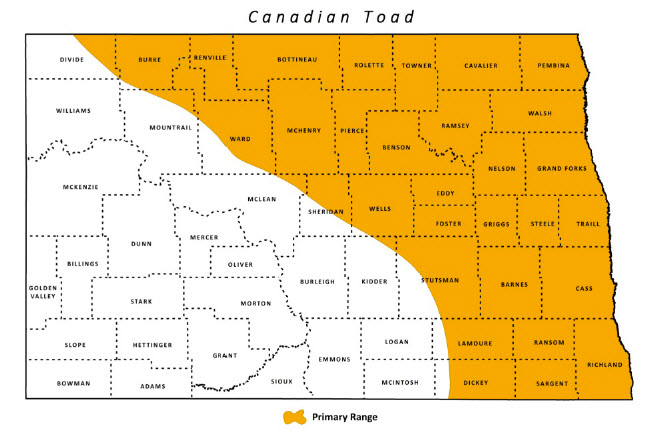
Canadian Toad
| Scientific Name | Anaxyrus hemiophrys |
|---|---|
| General Description | L 2-3”. Green to brown-red body with brown or red warts. A light line runs down center of back and a large raised bump, or boss, is present between the eyes. |
| Status | Year-round resident. |
| Abundance | Fairly common. |
| Primary Habitat | Margins of lakes, ponds, and a variety of wetlands. |
| Federal Status | No federal status. |
| Reason for Designation | North Dakota comprises the southern portion of the species’ rather limited range, which includes much of North Dakota, parts of Minnesota, South Dakota, Montana, and through central Canada. Vulnerable in the United States although apparently secure across the border in Canada. |
Locations and Conditions of Key Habitat
Preferred Habitat
The margin of lakes, ponds, and wetlands, particularly permanent water, are the Canadian’s toads preferred habitat. Considerably more aquatic than most toads, they will swim far into water for refuge. Burrows into the ground using its hind feet.
Key Areas and Conditions for Canadian Toad in North Dakota
Most commonly found in permanent water east of the Missouri River, although they do occur west of the Missouri. No key areas have been identified.
Problems Which May Affect this Species
Habitat
Wetland destruction and/or degradation. Lack of vegetation buffer around wetlands in agricultural fields may limit use.
Other Natural or Manmade Factors
Use of pesticides and herbicides may impact populations locally. Disease such as ranavirus and chytrid fungus may be very detrimental to amphibian populations.
Research and Survey Efforts
Current Research or Surveys
- North Dakota State University is surveying reptiles and amphibians in SE North Dakota.
- The University of North Dakota is currently studying diseases and parasites in amphibians.
Previous Research or Surveys
- Leonhart studied the effects of climate change on small mammals and herptiles in SW North Dakota in 2006.
- Shaunessy surveyed amphibians as part of a black-tailed Prairie Dog study in 2011.
- Cabarle and Beachy established population levels of amphibians at a number of sites in northern North Dakota in 2011.
- Wheeler and Wheeler (1966) conducted a statewide survey of all amphibians and reptiles, as well as compiled existing records. The toads were found east of the Missouri River and in reasonable numbers.
- The REAP program (1978) found two Canadian Toads in the ponderosa pines, the only records ever found west of the Missouri River.
- Hoberg and Gause (1992) recorded personal observations of Canadian Toads in North Dakota.
- A survey of calling amphibians conducted by Johnson and Batie (1996) found the toads only in the northeastern portion of the known range in North Dakota.
- A compilation of all records in North Dakota by Jundt (2000) listed roughly 60 documentations of the Canadian Toad in the state.
Additional Research or Surveys Needed
- Visual encounter surveys appear to work well with this species and should continue in the future.
- Disease monitoring as part of a larger monitoring protocol when feasible.
Management Recommendations
- Provide a buffer strip of natural vegetation between wetlands and agricultural areas of at least 50-60 feet.
- Provide adjacent upland habitat to wetlands of at least 500 feet.
- Leave logs, snags, and other coarse woody debris in place.
Monitoring Plans
There currently is no monitoring protocol in place. Monitoring tools could include school classes/programs, the general public, or national monitoring initiatives such as ARMI, NAAMP, or PARC. Amphibian monitoring can and should be directed at several species
2005-2015 Progress
The Canadian Toad maintains its Level I Species of Conservation Priority ranking. Sampling of amphibians has been conducted as part of number of SWG projects. A larger scale survey is currently underway (T-44-R Amphibian and reptile surveys of southeastern North Dakota). Work towards a monitoring protocol is needed.

Note: A listing of works consulted when compiling the information on this page may be found in the 2015 State Wildlife Action Plan.
